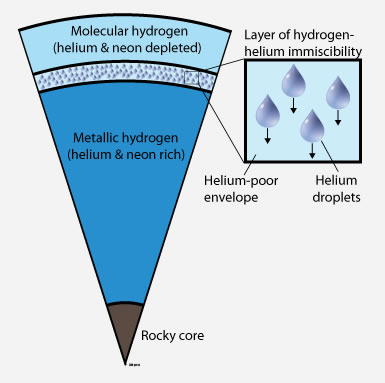Live by the cloud, die by the cloud. At least, that’s the way it felt this morning when I realized Gmail was down, and along with it, several emails with pointers to stories I had planned to look at for possible use today. But let’s talk about a different kind of cloud, for we still have the interesting news out of UC-Berkeley about what some reports are calling ‘helium rain’ on Jupiter. That’s a colorful way to describe an exotic process, but it may not be the best analogy given the difference between Earth’s comparatively gentle rainfall and the hellish conditions where neon ‘rain’ might fall.
After all, this is work aimed at creating models of planetary interiors, in this case a gas giant where helium forms droplets between 10,000 and 13,000 kilometers below the tops of Jupiter’s hydrogen clouds. Down in that realm pressures and temperatures reach absurd levels and both hydrogen and helium act like fluids. What we’re calling ‘rain’ then is actually made up of drops of fluid helium mixed with neon falling through another fluid, metallic hydrogen. Let me quote UCB’s Hugh Wilson on the matter:
“Helium condenses initially as a mist in the upper layer, like a cloud, and as the droplets get larger, they fall toward the deeper interior. Neon dissolves in the helium and falls with it. So our study links the observed missing neon in the atmosphere to another proposed process, helium rain.”

Wilson has been working on these matters with colleague Burkhard Militzer, whose 2008 computer simulations depicted Jupiter’s rocky core as surrounded by a layer of methane, water and ammonia ices that is twice as large as previously thought. The modeling takes into account what happens to hydrogen and helium as temperatures and pressures increase. This kind of work has to be modeled on a computer because we can’t reproduce conditions this extreme in a laboratory. The current work grows out of an observation by the Galileo probe as it plunged to its death in Jupiter’s atmosphere in 1995. The Galileo data showed that neon was only about one-tenth as abundant as found on the Sun.
Image: A slice through the interior of Jupiter shows the top layers that are depleted of helium and neon, the thin layer where helium drops condense and fall, and the deep interior where helium and neon again mix with metallic hydrogen. Credit: Burkhard Militzer.
Getting neon out of the upper atmosphere involves having it mix with helium (the two mix easily), and the new work shows that temperatures of 5,000 degrees Celsius and pressures up to 2 million times the atmospheric pressure of Earth can turn hydrogen into a conductive metal. Not yet a metal at this point, helium does not mix with the metallic hydrogen and thus forms drops. Helium and neon again mix with hydrogen in Jupiter’s deeper interior. Says Militzer:
“As the helium and neon fall deeper into the planet, the remaining hydrogen-rich envelope is slowly depleted of both neon and helium. The measured concentrations of both elements agree quantitatively with our calculations.”
So we’re learning more about what conditions may be like deep within the largest planet in our Solar System, and that’s helpful because the Juno mission is scheduled to be launched to Jupiter next year. Among other things, Juno will be making maps of the giant planet’s gravity, magnetic fields and atmospheric composition from a polar orbit, revealing the mass of its core and deepening our understanding of how such planets form. In turn, that gives us insights into the gas giants we’re discovering around other stars.
The paper is Wilson and Militzer, “Sequestration of Noble Gases in Giant Planet Interiors,” Physical Review Letters 104, 121101 (2010) (abstract).



so what do you think, MR. paul, could a life form exist there.?
I don’t have the background to answer that question, but it’s true that various notions of airborne life-forms developing in Jupiter’s clouds have been advanced in the past. Have a look at this post on Edwin Salpeter, for example:
https://centauri-dreams.org/?p=6308
Hi Paul
Ben Bova’s Jovian Whales are 50,000 km down in the sea at the bottom of the hydrogen. I sent him the news about Militzer’s work and he seemed pleased. Of course what chemistry could occur in such super-pressure molecular fluid is beyond computation or experiment presently, but why not?
“It’s Life Jim, but not as we know it…”
Not as we know it indeed!
I have already read his paper. so ,Adam I can conclude that entire universe is alive and filled with exotic life forms we don,t know about it yet. It,s a life not as we know..
Adam, can you remember robert forward,s cheela thriving in the crust of netron stars?wouldn,t it be extremum one,? could it exist?
Hmmm… this could have some bearing on the terraforming and manufacture of colonies in brown dwarf systems, since presumably the Neon contents there would be reduced. Are other elements affected, or just Neon?
Imagine a ‘naked’ super Jovian or brown dwarf – such a place could be colonised if their are resources in the atmosphere to use.